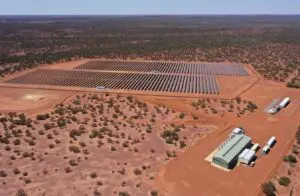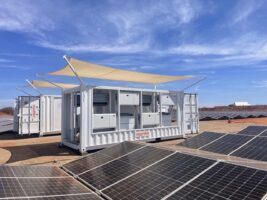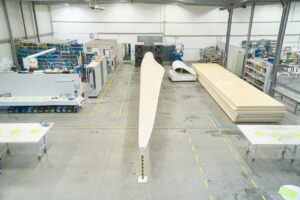An anti-renewables protest pitting Australia’s regions and their communities against large-scale solar and wind and transmission projects have inspired a number of counter movements, including a group of farmers who say the lease payments from renewable energy projects have kept their farms afloat.
Representatives of the Farmers for Climate Action gathered in Canberra on Monday to share the benefits of hosting renewable energy projects in certain regions and hit back at claims that clean energy is wrecking the agriculture industry.
The event, which attracted about 20 farmers, comes on the back of Farmers for Climate Action polling last week that shows renewable energy projects are near the bottom of the list of concerns held by regional Australians.
Rather, those polled said the biggest threats to farming in their local regions were “increased fires and floods driven by climate change” (39.2%), “commercial conduct by big supermarket chains” (18.7%) and “increasing cost of insurance and fertiliser and other inputs” (17.5%). Just 5.3% nominated the construction of transmission lines on farmland and 7.6% said renewable energy projects.
On the other hand, the poll found that regional people believed tourism (28.9%) to be the biggest opportunity for their community in the next 20 years, followed by renewable energy (21.6%) and healthcare employment (15.8%).
At the press conference on Monday, farmers were keen to debunk some of the myths that are being spread about using agricultural land for energy projects.
Susan Findlay-Tickner, a grain farmer near Horsham, Victoria, says farming with transmission lines is easier than around domestic power lines, because they’re higher which allows heavy machinery to operate up close underneath.
Her farm hosts 5.5km of transmission lines and 18 towers that were installed in the 1970s.
“One of the arguments is that you can’t fight fires under them. That is not true. We have had fires on our property over the years or neighbouring properties where we have seen fires fought under them. The CFA knows the protocols,” she told RenewEconomy.
“There is another argument about easements, but we don’t have any restrictions about how we can farm on those easements.”
In Wellington, New South Wales (NSW), Tony Inder says grazing his sheep under the neighbour’s solar panels has led to better quality and more wool. So much so that he sold his farm, to the solar company and bought elsewhere, with a view to run more stock under the expanding solar farm.
“They produce more wool on the same land before the panels were there,” he says.
“I think because there’s more even nutrition given the panels create shade in summer and provide a wind break in winter. My sheep are now part of a study investigating this.”
Renewables supporters begin campaign against anti groups
The farmers were speaking in Canberra a day before the Reckless Renewables event in the city, a well-funded protest with a speaking list that reads like a who’s who of prominent Australian clean energy opponents from state and commonwealth Liberal, National and minor parties, conservative think tanks and anti-renewables action groups.
That rally is calling on the federal government to halt all solar, wind and battery projects and instead look to nuclear to solve Australia’s power problems.
One of their claims is that solar, wind and batteries will harm productive farmland and somehow threaten food production.
However, the risks that real farmers have identified as risks to food production are largely linked to the impacts of climate change. Hosting renewables can help farmers to do their bit to combat global warming, while offering extra income and an economic boost to the community.
The Farmers for Climate Action polling found that farmers in Central Queensland, Hunter and Illawarra rank tourism and renewable energy projects as the two highest opportunities for rural areas in the next 20 years.
That survey follows another in December, which found that only 1 per cent of farmers see transmission as the greatest threat to their farm and only 0.6 per cent see renewables as a threat.
Goulburn sheep farmer Charlie Prell said wind turbines saved his business during drought.
“Our family farm wasn’t financially sustainable during the drought until we hosted wind turbines. Now the farm has substantial, bankable income locked in every year whether it rains or not. And now we’re selling, the real estate agent says the secure income from renewable energy is driving my sale price up by hundreds of thousands of dollars,” he says.
Jobs, income are arguments against no campaign
The anti-renewables protesters are inspiring rallies across the east coast, with events in Newcastle and Wollongong in NSW, Gladstone in Queensland and in Gippsland, Victoria on the weekend seeing hundreds of people turn out in support of offshore wind and renewables more generally.
Locals in those areas are looking for the jobs that offshore wind will create for communities such as Morwell in Victoria, which are struggling to recover from the closure of Hazelwood and find new work opportunities as the other coal power stations close over the coming years.
Instead of fiery political speeches, the Wollongong event gave out free ice creams for children and cultivated a farmers market-like vibe to provide a safe space for people to discuss concerns and the issues at hand.
In Newcastle, workers, doctors and teachers were looking for job security as the future of the region’s coal mining industry is cast into doubt.
Wharfies Joanna Tavita and Jasmine Loades told the ABC they hoped offshore wind could provide job security, as coal exports are expected to wind down in coming years.
And in Gippsland, Morwell residents braved the heat for a photo shoot with hand-made signs showing their support for wind and solar.
“We only organised this in a couple of days. It was fantastic to see a coal community out supporting renewable energy,” Latrobe Valley local and Friends of the Earth organiser Wendy Farmer told RenewEconomy.
“Our community is changing and we are embracing renewable energy. We know it is part of the future and we’re really sick and tired of others saying renewable energy won’t work. It’s not beneficial for regional areas to have this argument about renewable energy.”
Proper community engagement required
Community engagement will be core to winning over locals – the ones who are not already wedded to the anti-renewables talking points at least.
A review by Australian Energy Infrastructure found that poor community engagement has led to “material distrust” of renewable energy project developers and, in particular, developers of major new grid transmission projects.
The review suggests letting renewable energy and transmission project developers to opt in to an independent rating scheme that ranks their community engagement performance, track record and capability.
The review was released last week and is based on more than 75 meetings with 700-plus participants and more than 500 submissions.
It found that both landowners and developers are frustrated by instances of bad community engagement, which lets down the former and casts the latter in a negative light, even when they’re trying to do the right thing.










